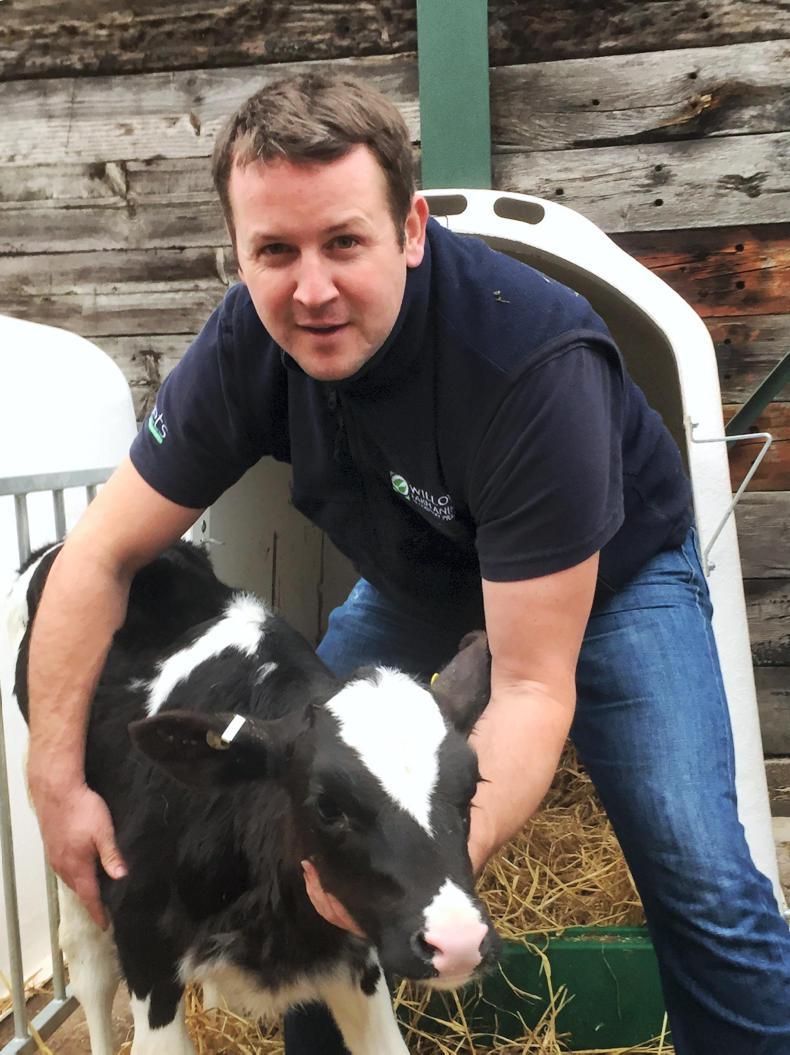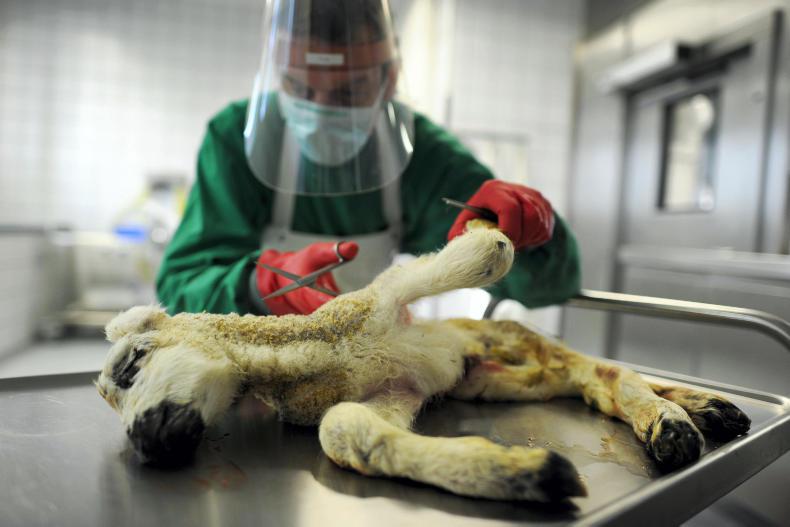Two separate incidences of Schmallenberg (SBV) have been confirmed. The Department of Agriculture confirmed to the Irish Farmers Journal that there were two cases of SBV found in bovine foetuses in counties Cork and Laois at the end of 2016. These are the first cases of SBV in Ireland since 2013. The Department is carrying out a serological survey to establish the extent of the outbreak but the risk of widespread infection is considered to be low.
Meanwhile, a livestock farmer in the southeast has notified his vet of a suspected case of SBV in lambs born on his farm this week. The farmer had a case of the virus in his flock in 2012 and is familiar with the symptoms. The case is being investigated.
UK incidents
The virus can cause congenital deformities in calves and lambs and its incidence has been rising in the UK in recent weeks. There has been a sharp increase in the number of suspected cases reported in the north of England and Wales, with the virus identified in bulk milk samples, while births of deformed animals are now starting to occur, albeit in small numbers to date.
Darrell Irwin, a veterinary practitioner with Willows Farm Veterinary Practice in Northwich, Cheshire, says the first sight of the virus returning occurred in autumn 2016.
“Dairy herds were first to report activity following the identification of antibodies to the virus in bulk milk samples,” Irwin said.
“The virus has also been linked to abortions in cows which suggests the virus, which caused so much trouble in 2012 and 2013, could be set to return. We advised clients to be vigilant and in the last two weeks have encountered many cases of difficult births due to congenital deformities.
“Vets in our other branches near Shropshire and North Wales have also experienced similar cases with birth deformities the same as those encountered when Schmallenberg last hit. 
"Lambing is only starting and calving will only really get going in the coming weeks so it’s early days to know how widespread the problem is. All we can do for now is to continue to advise farmers to be extra vigilant around calving and lambing and to take necessary precautions where appropriate. Hopefully midge activity will have eased by the main risk period for peak calving and lambing (March)," Irwin added.
Symptoms and effects
The most serious threat of the virus is if biting midges bite pregnant animals. Where this occurs, it can cause the birth of malformed offspring or abortion.
The malformations include animals born with fixed joints (will not bend as normal) or bent limbs or marked damage to the spinal cord. These offspring are generally stillbirth or die shortly after death with the virus differing to other abortion causing illnesses that can result in the birth of mummified or decomposing foetuses.
Reports from 2012 also show that it is common for twin bearing ewes to give birth to one healthy and one infected lamb.
Animals can also be born and appear relatively free of physical malformations but can suffer from brain deformities or complications with the workings of their nervous system. The prevalence within flocks ranged from 15% to 20% on average in 2011/2012 but some flocks/herds experienced higher losses.
The virus is not believed to cause sheep or goats to exhibit any clinical signs of the disease but adult cattle can exhibit clinical signs whereby it can cause reduced milk yield, fever, loss of body condition, loss of appetite and diarrhoea in bovines.
Once bitten and infected, animals develop an immunity to the virus (cannot be infected in later life) after a relatively short period of time. It is reported that infected animals also carry the disease for around four days.
During this period the infection can be picked up by healthy biting midges that come in contact and bite an infected animal.
Read more
New vaccine for Schmallenberg
Two separate incidences of Schmallenberg (SBV) have been confirmed. The Department of Agriculture confirmed to the Irish Farmers Journal that there were two cases of SBV found in bovine foetuses in counties Cork and Laois at the end of 2016. These are the first cases of SBV in Ireland since 2013. The Department is carrying out a serological survey to establish the extent of the outbreak but the risk of widespread infection is considered to be low.
Meanwhile, a livestock farmer in the southeast has notified his vet of a suspected case of SBV in lambs born on his farm this week. The farmer had a case of the virus in his flock in 2012 and is familiar with the symptoms. The case is being investigated.
UK incidents
The virus can cause congenital deformities in calves and lambs and its incidence has been rising in the UK in recent weeks. There has been a sharp increase in the number of suspected cases reported in the north of England and Wales, with the virus identified in bulk milk samples, while births of deformed animals are now starting to occur, albeit in small numbers to date.
Darrell Irwin, a veterinary practitioner with Willows Farm Veterinary Practice in Northwich, Cheshire, says the first sight of the virus returning occurred in autumn 2016.
“Dairy herds were first to report activity following the identification of antibodies to the virus in bulk milk samples,” Irwin said.
“The virus has also been linked to abortions in cows which suggests the virus, which caused so much trouble in 2012 and 2013, could be set to return. We advised clients to be vigilant and in the last two weeks have encountered many cases of difficult births due to congenital deformities.
“Vets in our other branches near Shropshire and North Wales have also experienced similar cases with birth deformities the same as those encountered when Schmallenberg last hit. 
"Lambing is only starting and calving will only really get going in the coming weeks so it’s early days to know how widespread the problem is. All we can do for now is to continue to advise farmers to be extra vigilant around calving and lambing and to take necessary precautions where appropriate. Hopefully midge activity will have eased by the main risk period for peak calving and lambing (March)," Irwin added.
Symptoms and effects
The most serious threat of the virus is if biting midges bite pregnant animals. Where this occurs, it can cause the birth of malformed offspring or abortion.
The malformations include animals born with fixed joints (will not bend as normal) or bent limbs or marked damage to the spinal cord. These offspring are generally stillbirth or die shortly after death with the virus differing to other abortion causing illnesses that can result in the birth of mummified or decomposing foetuses.
Reports from 2012 also show that it is common for twin bearing ewes to give birth to one healthy and one infected lamb.
Animals can also be born and appear relatively free of physical malformations but can suffer from brain deformities or complications with the workings of their nervous system. The prevalence within flocks ranged from 15% to 20% on average in 2011/2012 but some flocks/herds experienced higher losses.
The virus is not believed to cause sheep or goats to exhibit any clinical signs of the disease but adult cattle can exhibit clinical signs whereby it can cause reduced milk yield, fever, loss of body condition, loss of appetite and diarrhoea in bovines.
Once bitten and infected, animals develop an immunity to the virus (cannot be infected in later life) after a relatively short period of time. It is reported that infected animals also carry the disease for around four days.
During this period the infection can be picked up by healthy biting midges that come in contact and bite an infected animal.
Read more
New vaccine for Schmallenberg







 This is a subscriber-only article
This is a subscriber-only article






SHARING OPTIONS: